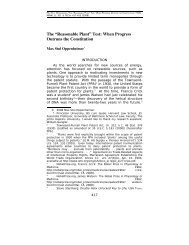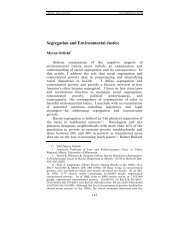An Organizational Approach to the Design of Patent Law
An Organizational Approach to the Design of Patent Law
An Organizational Approach to the Design of Patent Law
Create successful ePaper yourself
Turn your PDF publications into a flip-book with our unique Google optimized e-Paper software.
6 VERTINSKY FINAL_JAD (DO NOT DELETE) 2/27/2012 2:20 PM<br />
2012] AN ORGANIZATIONAL APPROACH 231<br />
bounded rationality, transaction costs, and uncertainty. 83 As he<br />
describes, “[a]ttributes <strong>of</strong> human ac<strong>to</strong>rs that bear crucially on<br />
<strong>the</strong> lens <strong>of</strong> contract/governance are cognition, self-interest, and<br />
foresight (where <strong>the</strong> last can be considered an extension upon<br />
cognition).” 84 Human ac<strong>to</strong>rs act with bounded rationality,<br />
meaning that <strong>the</strong>y respond rationally in <strong>the</strong> face <strong>of</strong> imperfect<br />
information and <strong>the</strong> need <strong>to</strong> economize in making decisions–<br />
<strong>the</strong>y attempt “rationally <strong>to</strong> cope.” 85 They act with self-interest,<br />
meaning that routine activities occur in a spirit <strong>of</strong> cooperation<br />
give way <strong>to</strong> a more calculative orientation as <strong>the</strong> stakes for defection<br />
increase. 86 The capacity for “feasible foresight” allows<br />
parties <strong>to</strong> limit some <strong>of</strong> <strong>the</strong> negative effects <strong>of</strong> this opportunism<br />
by constructing mechanisms that allow for credible commitments<br />
<strong>to</strong> behave cooperatively. 87<br />
To operationalize this transaction cost approach, Williamson<br />
emphasizes a focus on specific phenomena, such as <strong>the</strong> paradigmatic<br />
NIE problem <strong>of</strong> vertical integration. 88 “The transaction<br />
is made <strong>the</strong> basic unit <strong>of</strong> analysis, and is <strong>the</strong>reafter<br />
dimensionalized (with emphasis on asset specificity, contractual<br />
disturbances (uncertainty), and frequency).” 89 The focus is<br />
economizing on transaction costs through <strong>the</strong> alignment <strong>of</strong><br />
transactions and <strong>the</strong>ir different attributes with governance<br />
structures, which diverge in <strong>the</strong>ir cost and competence. 90 The<br />
framework is one <strong>of</strong> contracting, and <strong>the</strong> results are susceptible<br />
<strong>to</strong> empirical testing. 91 This methodology provides an important<br />
departure from <strong>the</strong> traditional approaches <strong>to</strong> patent <strong>the</strong>ory described<br />
in Part I; it is seeking <strong>to</strong> build a contextualized understanding<br />
<strong>of</strong> behavior out <strong>of</strong> a collection <strong>of</strong> observations that<br />
form <strong>the</strong> basis for modeling and testing, ra<strong>the</strong>r than starting<br />
with a general <strong>the</strong>ory that relies on empirical support based on<br />
limited data such as research and development (R&D) spending<br />
and patents filed.<br />
83. See Williamson, supra note 82, at 3–5.<br />
84. Oliver Williamson, Transaction Cost Economics: <strong>An</strong> Introduction 9<br />
(Econ. Discussion Papers, No. 2007-3, 2007) available at<br />
http://www.economics-ejournal.org/economics/discussionpapers/2007-3 (<strong>to</strong> access<br />
article, select download PDF).<br />
85. Id.<br />
86. Id. at 9–10.<br />
87. Id. at 10.<br />
88. Id. at 16.<br />
89. Id. at 17.<br />
90. Id. at 12.<br />
91. Id. at 17–18.






